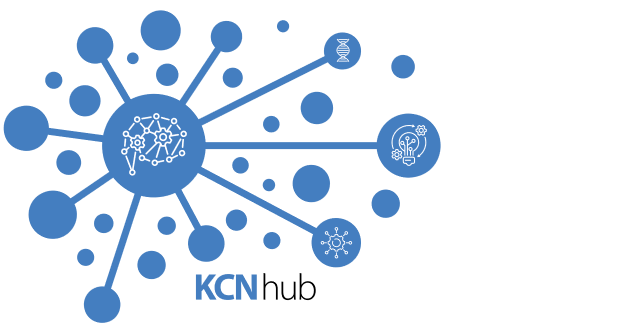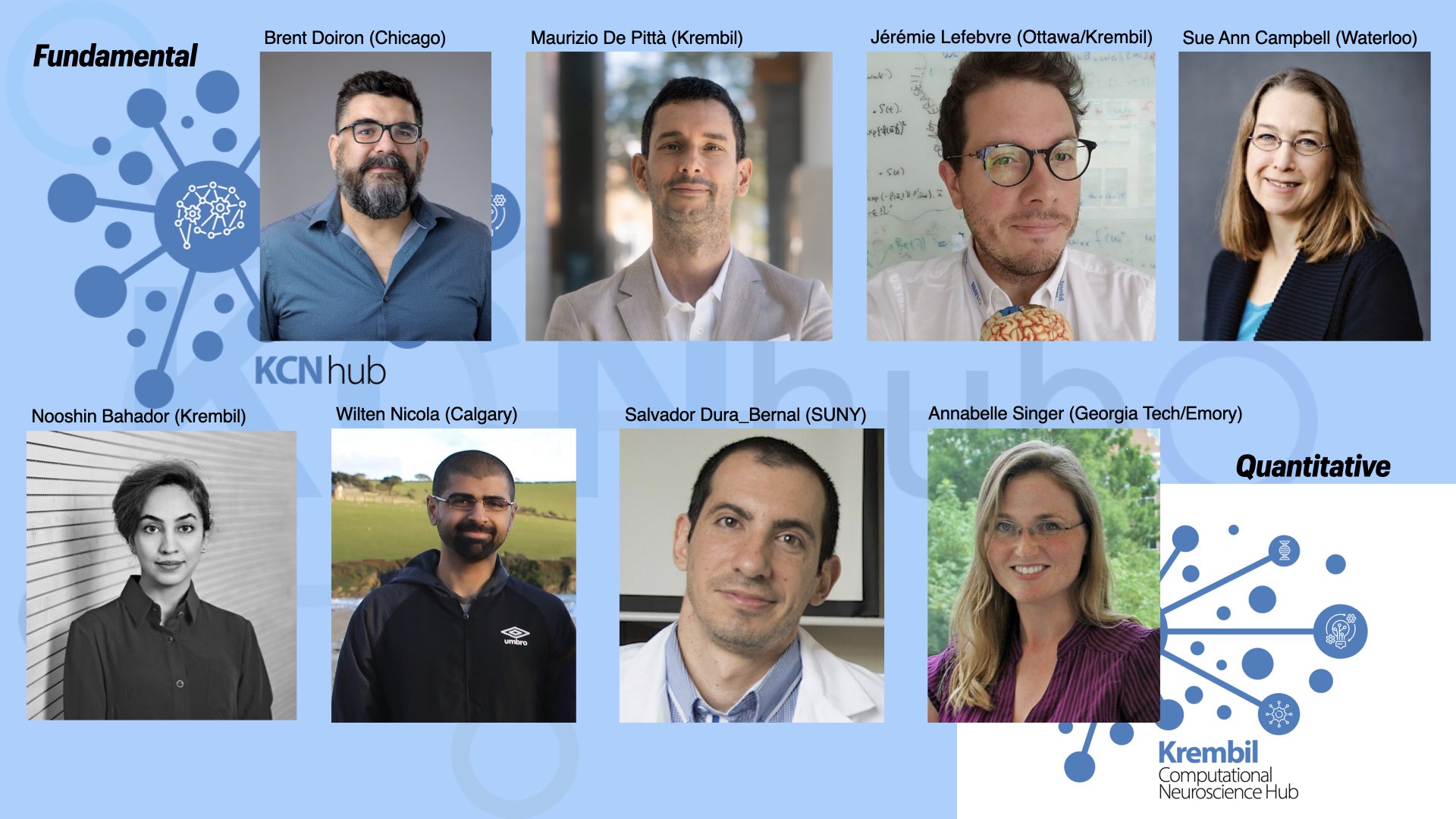KCN Symposium Speakers - DAY 1
Symposium Agenda can be found HERE
BRENT DOIRON
The dimensions of population variability in recurrent cortical circuits
Brief Bio: I completed my undergraduate and graduate degrees in Physics at the University of Ottawa, and later a postdoc at NYU. From 2007-2020 I was faculty in the Mathematics Department at the University of Pittsburgh, after which I moved to the University of Chicago where I am currently the Henrich Kluver Professor of Neurobiology and Statistics, and the director of the Grossman Center for Quantitative Biology and Human Behavior. My work focuses on how the complex circuit wiring of the nervous system supports rich, often stochastic dynamics, as well as drives neural computation. I have been fortunate enough to be awarded a Sloan fellowship, a Vannevar Bush Fellowship, and I am a Simons Foundation Investigator.
Abstract:
"We build and analyze mathematical models of networks of neurons that mimic the response and variability of cortical circuits. We use these models to understand the neuronal mechanisms that underlie sensation and cognition."
MAURIZIO DE PITTA
Neuron-glial networks for working memory
Brief Bio: Dr. Maurizio De Pitta’s primary affilation is with the Krembil Research Institute where he is the principal investigator of the Neuron-Glial Interaction Lab, and he is jointly-appointed Assistant Professor at the Department of Physiology within the Temerty Faculty of Medicine at the University of Toronto. Additionally, Dr. De Pitta has a dual appointment as a Scientist at the Basque Center for Applied Mathematics and an Adjunct Professor in the Neurosciences Program at the Faculty of Medicine at the University of the Basque Country, both in Bilbao, Spain. Dr. De Pitta earned his Ph.D. in Computational Biology from Tel Aviv University, where his research delved into intracellular calcium signaling under the mentorship of the late Eshel Ben-Jacob. His academic journey continued with postdocs in Theoretical Neurosciences between France and the United States at The University of Chicago under the mentorship of Nicolas Brunel. In 2018, he established his research group in Spain, and in 2021, he relocated to the Krembil Research Institute. Dr. De Pitta's research explores the significance of neuron-glial physiology at various levels in the healthy and diseased brain, from genes to Systems. Currently, he serves as the Principal Investigator for the European H2020 ASTROTECH Consortium, where he focuses on Disruptive Materials, Technologies, and Approaches to Unravel the Role of Astrocytes in Brain Function and Dysfunction, ultimately advancing our understanding of glial interfaces. Moreover, he co-founded CliSyNe: The Spanish Clinical System Neuroscience Network, along with the late Dr. Elena Galea.
Abstract: Non-neuronal glial cells, such as astrocytes, are widespread in the brain, infiltrating the neuropil and enwrapping synaptic processes. While essential for metabolic support of neurons, astrocytes also participate in numerous bidirectional signaling interactions with synapses, thereby emerging as active contributors to information processing within the brain. In this presentation, we introduce a theoretical framework designed to elucidate this phenomenon by harnessing the concept of gliotransmission, that is the activity-dependent focal release of neurotransmitters from astrocytes. We aim to demonstrate how gliotransmission can exert a significant influence on synaptic physiology, encompassing aspects ranging from transmission to plasticity. Furthermore, we explore its potential relevance to cognitive functions, shedding light on novel astrocyte-mediated mechanisms that may underlie working memory.
"We build computational models that link genomics and behavior, unraveling molecular and cellular interactions from single synapses to large networks in the brain."
JEREMIE LEFEBVRE
Intrinsic diversity promotes the resilience of neural circuits
Brief Bio: Jeremie Lefebvre is an affiliate scientist at the Krembil Brain Institute and Associate Professor at the Department of Biology of the University of Ottawa. Trained as a physicist in Ottawa, Geneva and Lausanne, his research focuses on neuroimaging, computational neuroscience and non-linear dynamics. His team combines modelling and data understand the physiological and pathological mechanisms underlying brain health and disease. Jeremie Lefebvre’s interdisciplinary research program is deeply collaborative and geared towards translation in biomedicine. He works closely with experimentalists and clinicians worldwide on brain stimulation, white matter plasticity, and epilepsy.
Abstract:
SUE ANN CAMPBELL
Exact mean-field models for neural systems
Brief Bio: Sue Ann Campbell received the B.Math. degree in Applied Mathematics from the University of Waterloo in 1986 and the Ph.D. in Theoretical and Applied Mechanics from Cornell University in 1991. After holding positions as a Postdoctoral Fellow at the University of Montreal and as an Assistant Professor at Concordia University, she joined the University of Waterloo in 1994. She is currently a Professor and University Research Chair in the Department of Applied Mathematics, holds a cross-appointment to the Department of Biology and is a founding member of the Centre for Theoretical Neuroscience. Sue Ann's research is focussed on developing and analyzing reduced models for neural systems. She uses these models to understand dynamical behaviour such synchronization and the formation of rhythms, and the effects of time delays on this behaviour.
Abstract:
NOOSHIN BAHADOR
Monitoring seizure development and drug response
Brief Bio: Dr. Nooshin Bahador holds a Ph.D. in Electrical Engineering and has accumulated over five years of experience in algorithm development, data science, signal processing, computational neuroscience, data visualization, and machine learning. She is passionate about bridging the gap between research and practical applications, especially in the field of medical technology. Currently, as a Senior Researcher at the Krembil Research Institute, her research is centered around the analysis and inference of neural activities. Furthermore, she plays a leading role in the Research IDEA Subcommittee at Canada's University Health Network and serves as a key member of the UHNPA leadership committee.
Abstract:
"Dr. Nooshin Bahador develops machine learning algorithms for analyzing brain signals. Her expertise areas are predictive analytics, signal processing and machine learning"
"We want to measure the efficacy of anti-seizure pharmacological agents based on the way they change neural signatures"
WILTEN NICOLA
Learning and memory in the paraventricular nucleus
Brief Bio: Dr. Nicola is devoted to analyzing how networks of neurons come together to perform behaviours or display emergent dynamics. Dr. Nicola utilizes techniques from dynamical systems and bifurcation theory, applied mathematics, and machine learning to investigate neural networks, both biological and artificial. Dr. Nicola completed his PhD in 2015 under the supervision of Prof. Sue Ann Campbell, at the University of Waterloo. Dr. Nicola completed a postdoctoral position with Prof. Claudia Clopath, at Imperial College London, after which he began his faculty position at the University of Calgary, Cumming School of Medicine, in 2019. He is currently a Tier II Canada Research Chair in Computational Neuroscience.
Abstract: The hypothalamic stress response is kicked off by the corticotropin releasing hormone (CRH) neurons of the paraventricular nucleus (PVN-CRH). As these neurons act as the final neural controller for the stress response, they are uniquely suited to adapting their neural responses to novel information in potentially stressful environments. Here, with both computational modelling and in vivo one-photon/miniscope recordings of PVN-CRH neurons, we show that these neurons change their tuning properties to novel environments with simple supervised learning rules in the absence or presence of threats or rewards. These changes persist across days and can be induced with only a single exposure to an environment paired with either an aversive stimulus (foot shock) or reward (Nutella). This work was performed in collaboration with the lab of Jaideep Bains .
SALVADOR DURA-BERNAL
Multiscale modeling of brain circuits to study brain function and disease"
Brief Bio: Salvador Dura-Bernal is an Assistant Professor in the Physiology and Pharmacology department at SUNY Downstate, and a Research Scientist at the Nathan Kline Institute for Psychiatric Research. He completed his PhD and first postdoc at the University of Plymouth, UK; followed by postdocs at Johns Hopkins and SUNY Downstate. His research focuses on understanding cortical circuits through large-scale biophysically-detailed simulations. Dr. Dura-Bernal has developed detailed models of motor, somatosensensory and auditory thalamocortical circuits, and a software tool (www.netpyne.org) for multiscale modeling of brain circuits, which has been used in over 50 labs. The models provide insights into cortical dynamics and disease, and can help develop new hypotheses, guide experimentation and evaluate new treatments. He received the the 2017 Best Use of AI Award from HPCwire, a leading supercomputing publication; the 2019 Robert Furchgott Scholar Award, an early career investigator prize; and in 2021 was selected as a Google Cloud Research Innovator. Dr. Dura-Bernal has been awarded grants as Principal Investigator from the National Institutes of Health (NIH), the National Science Foundation (NSF) and the NY State Spinal Cord Injury Board. For more information visit the Dura-Bernal Lab website: http://dura-bernal.
Abstract: Understanding brain function requires studying the brain components and interactions at different scales: molecular, cellular, circuit, system and behavior. Biophysically detailed modeling provides a tool to integrate, organize and interpret experimental data at multiple scales and translate isolated knowledge into an understanding of brain function. We developed detailed biophysical models of motor, somatosensory and auditory thalamocortical circuits, each with approximately ~15k detailed neurons and ~30M synapses. The models integrate previously isolated experimental data at multiple scales into a unified simulation, including neuronal densities, classes, morphology, biophysics, and connectivity. These models generated predictions about the long-range and neuromodulatory inputs underlying behavioral changes, and their multiscale effects across specific layers and cell types, and predicted how thalamocortical interactions generate different oscillatory patterns. The models also provided insights into the biophysical underpinnings of different brain diseases and disorders, including Parkinson's, dystonia, schizophrenia and epilepsy. Multiscale brain circuit models provide a theoretical framework for researchers to evaluate hypotheses, make predictions and guide the design of new experiments. We also develop the NetPyNE tool (http://netpyne.org) which facilitates building these multiscale brain circuit models, making this technology accessible to the wider community. Unraveling the non-intuitive multiscale interactions occurring in brain circuits can help us understand disease mechanisms and develop new treatments for brain disorders.
ANNABELLE SINGER
Learning from inhibition: Hippocampal interneurons unlock plasticity at new goal locations"
Brief Bio: Annabelle Singer is the McCamish Foundation Early Career Professor in the Coulter Department of Biomedical Engineering at Georgia Tech and Emory University. Her research aims to understand how neural activity produces memories and controls brain immune function. Dr. Singer’s research has shown how coordinated electrical activity across many neurons in the hippocampus represents memories of experiences and fails in animal models of Alzheimer’s disease. Dr. Singer has found that driving particular patterns of neural activity, like gamma, reduces Alzheimer’s pathology and alters brain immune function. Using non-invasive sensory stimulation to control neural activity, she is translating her discoveries from rodents to humans to develop radically new ways to treat disease. Her research has inspired multiple clinical trials of brain stimulation to treat neurodegenerative disease. Dr. Singer completed a post-doctoral fellowship in Ed Boyden’s Synthetic Neurobiology Group at MIT and she received her Ph.D. in Neuroscience from UCSF, performing research in the laboratory of Loren Frank. She is a Packard Fellow, Kavli Fellow, and recipient of the National Academy of Engineering Gilbreth Lectureship, the Society for Neuroscience’s Janett Rosenberg Trubatch Career Development Award, and the American Neurological Association’s Derek Denny-Brown Young Neurological Scholar Award.
Abstract:

